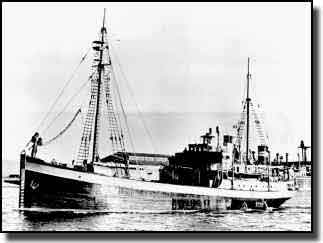|
Wyatt Earp, A Ship of Several Names and a Lifetime of Adventure.
Her Baltic timbers were 5 feet thick, and her two masts carried fore and aft auxiliary sails, consisting of a jib, stay sail, main and mizzen sails. One tall thin funnel was placed well aft. Early life. Sir Hubert Wilkins, the Australian explorer bought the ship, having been commissioned by the American, Lincoln Ellsworth to find and buy a vessel suitable for the Antarctic. Use in Antarctica. Ellsworh was an avaitor with a driving ambition to become the first flier to cross Antarctia by means of an aeroplane. He needed the ship to transport both him and his aircraft to a position where he could take off to achieve his aims. English oak, and steel plating were used to sheath Wyatt Earp’s hull, so she may be used in an ice breaking role In November 1935, the ship transported Ellsworth and his aircraft to Dundee Island, about 500 miles south of Cape Horn, and Ellsworth crossed the 2,000 miles between the Waddell Sea and Little America on the Ross Sea. From 1934 to 1938, this ship made four more visits to the polar regions of Antarctica. Bought by the Australian Government. WW2 years. Post war. Australian Scientific activities at Macquarie and Heard Islands. The ship now reverted to her Wyatt Earp name and was refitted at great cost, being practically rebuilt, a new 450 Horse Power, 8 cylinder Crossley diesel engine was installed, accommodation for 30 people upgraded, radar fitted, and modern equipment to measure cosmic rays and make magnetic observations was installed. Even a Sikorski-Kingfisher float plane was put onboard. Not withstanding spending vast amounts of money, the ship was believed to be too old, too small, and too slow for modern polar exploration, she did deliver scientists to both Heard and Macquarie Islands. One of my Naval College term, Norman White, as a Lieutenant RAN, was the Navigator onboard Wyatt Earp for the trip south with all the Australian scientists, he had survived the sinking of HMAS Perth by the Japanese in the Battle of Sunda Strait in March 1942, and being a Prisoner of War for over three years, he went on to attain the rank of Commodore in the Royal Australian Navy, and still thrives. Wyatt Earp, when in the southern seas, developed a serious leak, and was forced to return to Melbourne having failed to break through the Antarctic ice. Wyatt Earp sold by Australian government. Amidst a furore about the amount of money wasted in refitting the ship, the government offered her for sale, and in 1948, the Argo Shipping Company of St. Helens in Tasmania bought her for coastal tramp duties, and once more she became Wongala. For eight years this old vessel roamed the eastern and southern coasts of Australia, carrying a variety of cargo, then in 1956, the Ulverstone Shipping Company bought her for trading around the Queensland coast. The ship was renamed Natone, after a potato growing area around Ulverstone, on the 23rd. of January in 1959 she steamed out of Cairns southbound for Brisbane. She carried a crew of 6 Europeans and 12 native Papuans, during a cyclone, the ship developed leaks that the pumps could not accommodate, and the engine room soon flooded, the auxiliary sails were hoisted, and Natone sought to run for shelter. During the night she ran aground near Mudjow Rocks, 110 miles short of Brisbane, and became a total loss. Conclusion. |

